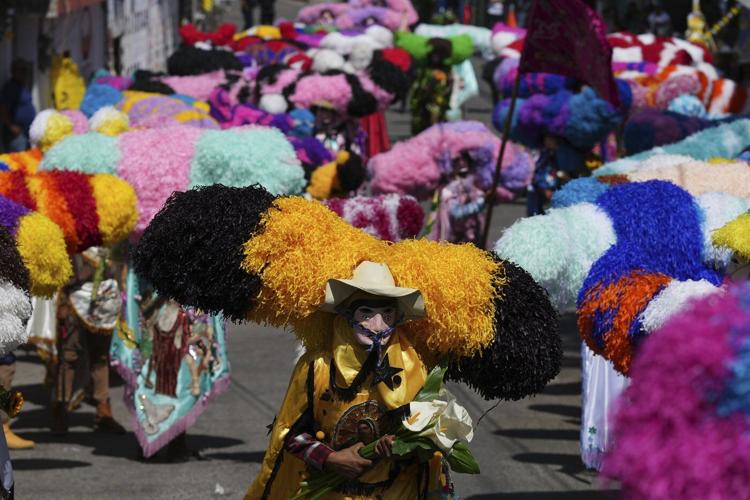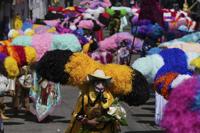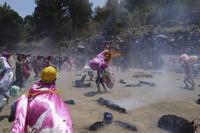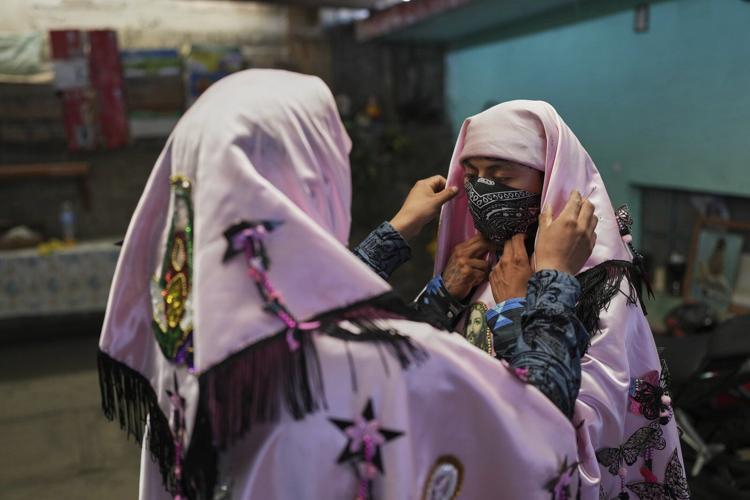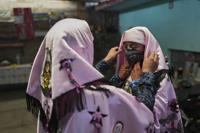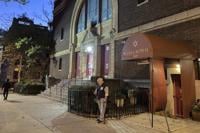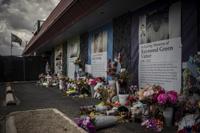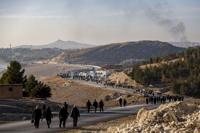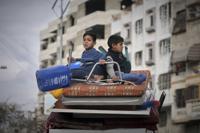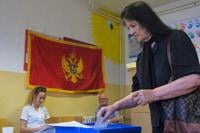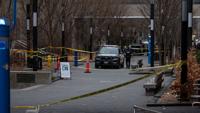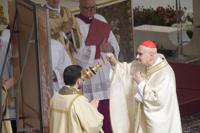TETELA DEL VOLCAN, Mexico (AP) — Every year, the winding mountain streets of Tetela del Volcán are filled with a crush of vivid yellows, purples, greens, oranges and blues.
Hundreds of what appear to be human-sized caterpillars with elaborate stripes bob along the road.
Shaggy tissue paper hats resembling caterpillars sit atop the heads of men and women wearing bearded and mustached leather masks, and colored capes adorned with images of Jesus and Virgin Mary. The characters they portray are known as “sayones”.
These elaborate costumes, imitations of Roman soldiers, are part of a cherished Easter celebration dating back 350 years in the central Mexican town. Residents of town, which sits pressed up next to Mexico’s active Popocatépetl volcano, prepare for months for the three-day celebration every Easter weekend.
'It's part of our essence'
“The tradition, it’s part of our essence,” said José Alfredo Jimenez, the town’s director of tourism and culture. “It’s something that gives us our originality as Tetelans. No one else in Mexico does anything like this, it’s unique.”
Jimenez said the celebration came to be when European colonizers arrived to Latin America and attempted to evangelize local Indigenous communities to Catholicism, often spreading their religion through theatrical performances portraying figured from the crucifixion of Jesus, including Roman soldiers.
Throughout the years, the tradition grew to take on its own identity, mixing with local Mexican customs like many Easter and Holy Week celebrations across Latin America.
The hats of the sayones, meant to imitate the helmets worn by Roman soldiers, are the dominant part of the celebration, and have gradually grown more elaborate over the past 25 years as residents have sought to out-do each other.
Imitate the helmets worn by Roman soldiers
The hats were little more than vertical arm-length tufts when Jimenez began to participate as a teenager, but have slowly turned into two-meter-long, multi-colored puffs teetering on people’s heads as they march through the streets. Every year, residents pick new colors for their costume, from deep yellows and reds, to brilliant pinks and blues.
This year, 20-year-old Eduardo Canizal chose a three-pronged pink and black tissue paper structure, fastened to a black cowboy hat and with a cushion on the back of his neck to support the hat’s weight. Others fasten them onto construction hats or metal wire.
“Every year, you want to do something bigger, better and you keep going,” he said.
He said the hat is made up of around 900 sheets of tissue paper, which he began to cut into thin threads by hand over a month before.
Shortly before the procession, Canizal pulled on delicate pink cloaks, leather boots and a mask before heading out to the march.
“This weighs like 15-20 kilos (35-40 pounds), If I had to guess,” he said, leaning over and using his body’s momentum to swing the hat over his head.
Figures from story of Jesus' crucifixion
They march through the streets, clanging machetes, meant to imitate Roman swords, on the rocky earth. Others dress up as key figures in the Catholic story of the Jesus’ crucifixion like Pontius Pilate and Judas, who is chased through the streets of Tetela del Volcán.
Jimenez, the town’s cultural director, said it’s a celebration the town has clung to as other Easter marches and traditions like Mexico’s Day of the Dead have been flooded by tourists, often watering down longtime traditions.
In Tetela, more than a thousand people participated this year, he said, yet the celebration still remains local at its heart.
“You put on your mask, and everything changes, you transform,” Jimenez said. “We still try to keep alive this mystical side, Tetela’s signature, especially as we’ve seen other cultural activities suffer a change, a transformation for better or for worse.”
Cloaks portraying religious figures are delicately embroidered and some like Emilio Aguilar, 20, begin creating intricate designs with sequins and beads as early as July.
“You do this little by little, on your free time,” he said, waving his and over a two-food long embroidery of the Virgin Mary emblazoned on his back.
Aguilar, and a group of 12 friends and relatives, each dress identically in white and pastel colored hats.
Efforts go up in smoke
But all of those efforts quite literally go up in smoke at the end of the Easter celebration.
On Sunday afternoon, the costumed marchers solemnly lay a bouquet of flowers at the base of a stone church, then trek up a winding mountain slope trailed by paramedics.
As they run, neighbors, police officers and screaming little boys sling matches at the men until their paper hats burst into flames, often to the roar of the crowd. While authorities try to keep the flames confined to a stadium, celebrations quickly spill onto the streets.
Aguilar said it’s their way of paying penance on the Catholic holiday.
“After all these months of work, it’s a sacrifice of all the work that went into these,” he said.

